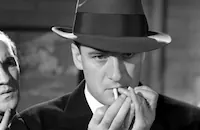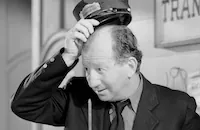Escape from Crime

Brief Synopsis
Cast & Crew
D. Ross Lederman
Richard Travis
Julie Bishop
Jackie C. Gleason
Frank Wilcox
Rex Williams
Film Details
Technical Specs

Synopsis
Parolee Red O'Hara pays a surprise visit to his wife Molly, expecting to find her with another man. Instead he learns that he is the father of a baby boy, whom Molly intends to keep away from criminals. Inspired by his new fatherhood, Red vows to go straight and searches for a job as a news photographer. He discovers that newspapers are reluctant to hire an ex-convict, but his luck changes when he happens to be on the scene of a bank robbery with his camera. Red's pictures of the robbery get him a job and also help the police identify the perpetrators. Lieutenant "Biff" Malone, Red's parole officer, is suspicious, however. He does not believe Red's presence near the bank was an accident and consequently shows up at the O'Hara's apartment at the same time Red is hiding a wounded friend, Slim Dugan, the driver of the getaway car. When Malone learns about Red's child, he finally believes that Red wants to go straight and apologizes for his suspicions. Later, Slim is arrested along with two other gang members, and Red is assigned to sneak a photograph of Slim's execution. Not wanting to see a friend die, Red turns down the assignment, until Reardon, his editor, offers to let him write the accompanying story. Although it means breaking his parole, Red asks Malone to arrange for him to return to the prison for the execution. Malone warns Red that he will have to arrest him if he is discovered at the execution. Red successfully photographs the event, and although his cover is revealed when he drops his camera as he leaves, he manages to dodge the pursuing reporters and deliver his film to the paper. After mailing his bonus to Molly, he gives himself up to Malone. On the way back to the prison, Malone and Red hear that Dude Merrill has escaped from prison. Red tips Malone to the location of Merrill's hideout, and leaving Red handcuffed in the police car, Malone goes after Merrill. After Malone is captured by Merrill's men, Red follows and pretends to be on Merrill's side. Once his handcuffs are removed, however, Red frees Malone and snaps a photo of the ensuing capture of Merrill and his men. Later, a grateful Malone arranges for Red's pardon.

Director

D. Ross Lederman
Cast

Richard Travis

Julie Bishop

Jackie C. Gleason
Frank Wilcox
Rex Williams
Wade Boteler
Charles Wilson

Paul Fix
Ruth Ford

John Hamilton
Ann Corcoran
Ben Taggart
John Harmon
Murray Alper

Elliott Sullivan
Jack Kenney
Lew Harvey

Hank Mann
Fred Kelsey
Creighton Hale

Hobart Bosworth
William Hopper
Bill Edwards
Jack Wise
Eddie Graham
Cliff Saum
Jack Gardner
Frank Mayo
Al Hill
Charles Sherlock
Norman Willis

Ray Teal

Jack Mower

Howard Mitchell
Crew

Film Details
Technical Specs

Articles
Escape from Crime
By Richard Harland Smith















